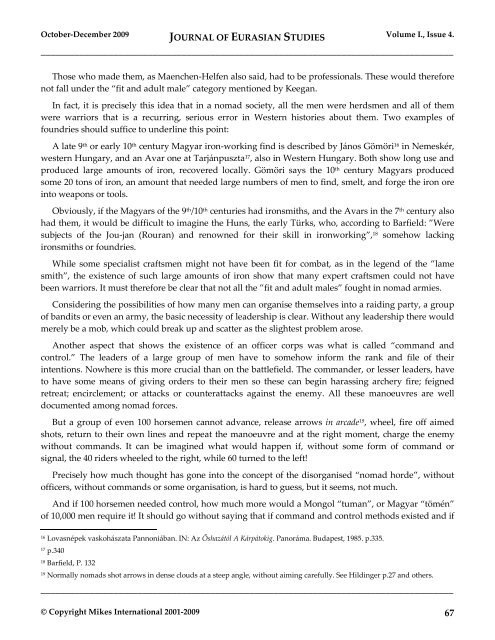JOURNAL OF EURASIAN STUDIES
JOURNAL OF EURASIAN STUDIES
JOURNAL OF EURASIAN STUDIES
You also want an ePaper? Increase the reach of your titles
YUMPU automatically turns print PDFs into web optimized ePapers that Google loves.
October-December 2009 <strong>JOURNAL</strong> <strong>OF</strong> <strong>EURASIAN</strong> <strong>STUDIES</strong> Volume I., Issue 4.<br />
_____________________________________________________________________________________<br />
Those who made them, as Maenchen-Helfen also said, had to be professionals. These would therefore<br />
not fall under the “fit and adult male” category mentioned by Keegan.<br />
In fact, it is precisely this idea that in a nomad society, all the men were herdsmen and all of them<br />
were warriors that is a recurring, serious error in Western histories about them. Two examples of<br />
foundries should suffice to underline this point:<br />
A late 9 th or early 10 th century Magyar iron-working find is described by János Gömöri 16 in Nemeskér,<br />
western Hungary, and an Avar one at Tarjánpuszta 17 , also in Western Hungary. Both show long use and<br />
produced large amounts of iron, recovered locally. Gömöri says the 10 th century Magyars produced<br />
some 20 tons of iron, an amount that needed large numbers of men to find, smelt, and forge the iron ore<br />
into weapons or tools.<br />
Obviously, if the Magyars of the 9 th /10 th centuries had ironsmiths, and the Avars in the 7 th century also<br />
had them, it would be difficult to imagine the Huns, the early Türks, who, according to Barfield: ”Were<br />
subjects of the Jou-jan (Rouran) and renowned for their skill in ironworking”, 18 somehow lacking<br />
ironsmiths or foundries.<br />
While some specialist craftsmen might not have been fit for combat, as in the legend of the ”lame<br />
smith”, the existence of such large amounts of iron show that many expert craftsmen could not have<br />
been warriors. It must therefore be clear that not all the ”fit and adult males” fought in nomad armies.<br />
Considering the possibilities of how many men can organise themselves into a raiding party, a group<br />
of bandits or even an army, the basic necessity of leadership is clear. Without any leadership there would<br />
merely be a mob, which could break up and scatter as the slightest problem arose.<br />
Another aspect that shows the existence of an officer corps was what is called “command and<br />
control.” The leaders of a large group of men have to somehow inform the rank and file of their<br />
intentions. Nowhere is this more crucial than on the battlefield. The commander, or lesser leaders, have<br />
to have some means of giving orders to their men so these can begin harassing archery fire; feigned<br />
retreat; encirclement; or attacks or counterattacks against the enemy. All these manoeuvres are well<br />
documented among nomad forces.<br />
But a group of even 100 horsemen cannot advance, release arrows in arcade 19 , wheel, fire off aimed<br />
shots, return to their own lines and repeat the manoeuvre and at the right moment, charge the enemy<br />
without commands. It can be imagined what would happen if, without some form of command or<br />
signal, the 40 riders wheeled to the right, while 60 turned to the left!<br />
Precisely how much thought has gone into the concept of the disorganised “nomad horde”, without<br />
officers, without commands or some organisation, is hard to guess, but it seems, not much.<br />
And if 100 horsemen needed control, how much more would a Mongol “tuman”, or Magyar “tömén”<br />
of 10,000 men require it! It should go without saying that if command and control methods existed and if<br />
16 Lovasnépek vaskohászata Pannoniában. IN: Az Őshazától A Kárpátokig. Panoráma. Budapest, 1985. p.335.<br />
17 p.340<br />
18 Barfield, P. 132<br />
19 Normally nomads shot arrows in dense clouds at a steep angle, without aiming carefully. See Hildinger p.27 and others.<br />
_____________________________________________________________________________________<br />
© Copyright Mikes International 2001-2009 67
















